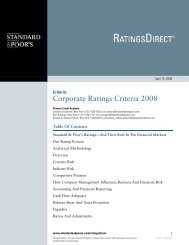European Infrastructure Finance Yearbook - Investing In Bonds ...
European Infrastructure Finance Yearbook - Investing In Bonds ...
European Infrastructure Finance Yearbook - Investing In Bonds ...
You also want an ePaper? Increase the reach of your titles
YUMPU automatically turns print PDFs into web optimized ePapers that Google loves.
failure due to human error or material failure can<br />
be a form of force majeure that may excuse a<br />
project from its contractual obligations. Despite<br />
excusing a project from its supply obligations, the<br />
force majeure event may still lead to a default<br />
depending on the severity of the mishap.<br />
Technology, construction, and operations<br />
<strong>In</strong> part, a project’s rating rests on the<br />
dependability of a project’s design, construction,<br />
and operation; if a project fails to achieve<br />
completion or to perform as designed, many<br />
contractual and other legal remedies may fail to<br />
keep lenders economically whole.<br />
The technical risk assessment falls into two<br />
categories: construction and operations.<br />
Construction risk relates to:<br />
■Engineering and design<br />
■Site plans and permits<br />
■Construction<br />
■Testing and commissioning<br />
Operations risk relates to:<br />
■Operations and maintenance (O&M)<br />
strategy and capability<br />
■Expansion if any contemplated<br />
■Historical operating record, if any<br />
Project lenders frequently may not adequately<br />
evaluate a project’s technical risk when making an<br />
investment decision but instead may rely on the<br />
reputation of the construction contractor or the<br />
project sponsor as a proxy for technical risk,<br />
particularly when lending to unrated transactions.<br />
The record suggests that such confidence may be<br />
misplaced. Standard & Poor’s experience with<br />
technology, construction, and operations risk on<br />
more than 300 project-finance ratings indicates<br />
that technical risk is pervasive during the pre- and<br />
post-construction phases, while the possibility of<br />
sponsors coming to the aid of a troubled project<br />
is uncertain. Thus, we place considerable<br />
importance on a project’s technical evaluation.<br />
We rely on several assessments to complete our<br />
technical analysis. One key element is a reputable<br />
independent expert’s (IE) project evaluation. We<br />
examine the IE’s report to see if it has the proper<br />
scope to reach fundamental conclusions about the<br />
project’s technology, construction plan, and<br />
expected operating results, and then we determine<br />
whether these conclusions support the sponsor’s<br />
STANDARD & POOR’S EUROPEAN INFRASTRUCTURE FINANCE YEARBOOK<br />
PROJECT FINANCE/PUBLIC-PRIVATE PARTNERSHIPS<br />
and EPC contractor’s technical expectations. We<br />
supplement our review of the IE’s report with<br />
meetings with the IE and visits to the site to<br />
inspect the project and hold discussions with the<br />
project’s management and construction contractor<br />
or manager. Without an IE review, Standard &<br />
Poor’s will most likely assign a speculative-grade<br />
debt rating to the project, regardless of whether<br />
the project is in the pre- or post-construction<br />
phase. Finally, we will assess the project’s<br />
technical risk using the experience gained from<br />
examining similar projects.<br />
Another key assessment relates to the potential<br />
credit effect of a major equipment failure that<br />
could materially reduce cash flow. This analysis<br />
goes hand-in-hand with the contractual<br />
implications of force majeure events, described<br />
above, and counterparty risk, described below. If<br />
the potential credit risk from such an event is not<br />
mitigated, then a project’s rating would be<br />
negatively affected. Mitigation could be in the<br />
form of business-interruption insurance, cash<br />
reserves, and property casualty insurance. The<br />
level of mitigation largely depends on the project<br />
type--some types of projects, such as pipelines and<br />
toll roads--are exposed to low outage risks and<br />
thus could achieve favorable ratings with only<br />
modest risk mitigation. <strong>In</strong> contrast, a<br />
mechanically complex, site-concentrated project-such<br />
as a refinery or bio-mass plant--can be<br />
highly exposed to major-equipment-failure risk,<br />
and could require robust features to deal<br />
with potential outages that could take months<br />
to repair.<br />
Resource availability<br />
All projects require feedstock to produce output,<br />
and we undertake a detailed assessment of a<br />
project’s ability to obtain sufficient levels. For<br />
many projects, the input-supply risk largely hinges<br />
on the creditworthiness of the counterparty that is<br />
obligated to provide the feedstock, which is<br />
discussed below under Counterparty Exposure.<br />
Other types of projects, however, such as wind<br />
and geothermal power, rely on the type of natural<br />
resources of which few third parties are willing to<br />
guarantee production. <strong>In</strong> these cases, we require<br />
an understanding of the availability of the natural<br />
resource throughout the debt tenor. We use<br />
various tools to reach our conclusions, but most<br />
important will be the analysis and conclusions of<br />
a reputable IE or market consultant on the<br />
NOVEMBER 2007 ■ 97



